Instructor Details
More Courses by LNG CHEMICAL SCIENCES.
Objective Physical Photochemistryby LNG CHEMICAL SCIENCES.
Objective Coordination Chemistryby LNG CHEMICAL SCIENCES.
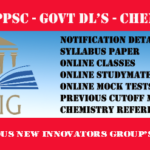
APPSC GOVERNMENT DEGREE COLLEGE LECTURERS CHEMISTRY ONLINE MOCK TESTSby LNG CHEMICAL SCIENCES.
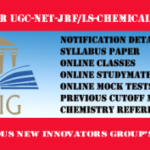
CSIR UGC NET CHEMICAL SCIENCES ONLINE MOCK TESTSby LNG CHEMICAL SCIENCES.
AP POLICE CHEMICAL SCIENTIFIC ASSISTANTby LNG CHEMICAL SCIENCES.

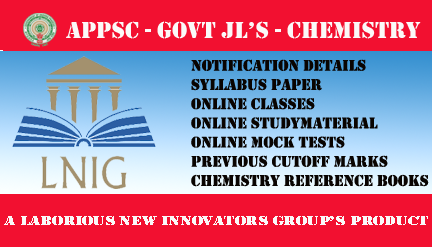
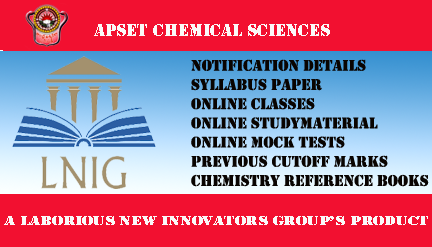
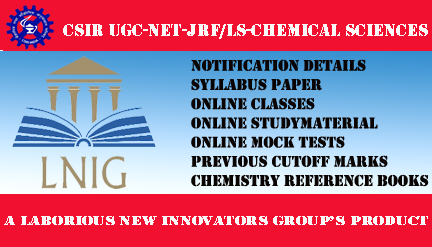
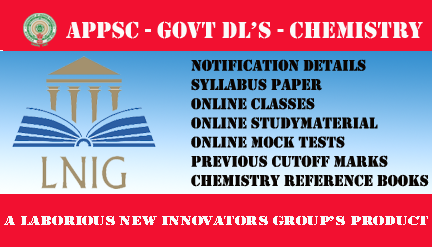

APPSC Government Junior College Lecturers Chemistry Syllabus Paper & analysis.
I. INORGANIC CHEMISTRY:
1. Atomic structure and chemical bonding: structure and bonding in homo and heteronuclear molecules. Applications of VSEPR, Valence Bond, and Molecular orbital theories in explaining the structures of simple molecules.
2. Transition elements and coordination compounds: physical and chemical characteristics of transition elements, Bonding theories, crystal field theory, crystal field splitting patterns in various geometries, Calculation of CFSE, Jahn-Teller effect, Application of MO theory to octahedral and square planar complexes, Electronic spectra of complexes, Russell Saunders coupling, term symbols, spectra of octahedral and tetrahedral complexes, charge transfer spectra, magnetic properties of complex compounds.
3. Metal – ligand equilibria in solution: step wise and overall stability constants, factors affecting the stability of metal complexes, Pearson’s theory of hard and soft acids and bases (HSAB) – Chelate effect.
4. Reaction mechanisms in complexes Inert and level complexes, Ligand substitution reactions of octahedral complexes – Acid hydrolysis, base hydrolysis, conjugate base mechanism, Anation reactions, substitution reactions of square planar complexes – Trans effect, Electron transfer reactions – Inner and outer sphere mechanisms.
5. Metal complexes: EAN rule, structure and bonding of metal carbonyls of Mn, Fe, Co and Ni, Metal nitrosyls – structure and bonding.
6. Cages and ring compound: preparation, structure and reactions of boranes and carboranes, Boron-nitrogen and Sulfur-nitrogen cyclic compounds.
7. Metal clusters: factors favoring M-M bonds – Structure and bonding in Re2Cl8, Mo6Cl8,Nb6X12, Re3Cl9 and Re3Cl12.
8. Bio-inorganic chemistry: metal complexes as oxygen carriers – hemoglobin and myoglobin, oxygen transport – non heme proteins – hemerythrin and hemocyanin.
9. Analytical chemistry: chromatography – general principles involved in separations by paper, thin layer and column chromatography – GC and HPLC.
II. PHYSICAL CHEMISTRY:
1. Thermodynamics: Brief review of concepts of I and II laws of thermodynamics; Concept of entropy – Entropy as a state function, Calculation of entropy changes in various processes, Entropy changes in an ideal gas, Entropy changes on mixing of ideal gases, Entropy as a function of V and T, Entropy as a function of P and T, Entropy change in isolated systems- Clausius inequality, Entropy change as criterion for spontaneity and equilibrium; Third law of thermodynamics, Evaluation of absolute entropies from heat capacity data for solids, liquids and gases. Standard entropies and entropy changes of chemical reactions. Helmholtz and Gibbs free energies (A and G). A and G as a criteria for equilibrium and spontaneity. Physical significance of A and G. Driving force for chemical reactions- relative signs of ∆H and ∆S. Thermodynamic relations. Gibbs equations. Maxwell relations. Temperature dependence of G. Gibbs- Helmholtz equation. Pressure dependence of G. Chemical potential: Gibbs equations for non-equilibrium systems. Material equilibrium. Phase equilibium. Clapeyron equation and Clausius-Clapeyron equation . Conditions for equilibrium in a closed system. Chemical potential of ideal gases. Ideal-gas reaction equlibrium-derivation of equilibrium constant. Temperature dependence of equilibrium constant-the van’t Hoff equation. Solutions: Specifiying the Solution composition. Partial molar poperties-significance. Relation between solution volume and partial molar volume. Measurement of partial molar volumes- slope and intercept methods. The chemical potential. Variation of chemical potential with T and P. Gibbs-Duhem equation-derivation and significance Ideal solutions. Thermodynamic properties of ideal solutions. Mixing quantities. Vapour pressure-Raoult’s law. Thermodynamic properties of ideally dilute solutions. Vapour pressure- Henry’s law. Nonideal systems. Concept of fugacity, fugacity coefficeient. Determination of fugacity. Non ideal solutions. Activities and activity coefficients. Standard-state conventions for non ideal solutions. Determination of activity coefficients from vapour pressure measurements. Activity coefficients of nonvolatile solutes using Gibbs-Duhem equation. Multicomponent phase equilibrium: Vapour pressure lowering, freezing point depression and boiling point elevation.
2. Statistical Thermodynamics: Concepts of distribution and probability. Estimation of probability and the most probable distribution. Systems composed of noninteracting particles. Derivation of Boltzmann distribution law. The molecular partition function. Systems composed of interacting particles. The concept of ensemble and canonical ensemble. Canonical partition function and its relation to molecular partition function. The factorization of molecular partition function – translational, rotational, vibrational and electronic partition functions. Derivation of expressions for translational, rotational (diatomic) and vibrational partition functions. Relationship between partition functions and thermodynamic functions. The relationship between partition functions and thermodynamic functions. Specific heats of solids – Einstein equation of heat capacity of solids – derivation. Explanation of heat capacity at very low and very high temperatures – Dulong and Petits Law. Debye theory. The entropy of a monoatomic ideal gas. The Sackur-Tetrode equation derivation. Mean translational and vibrational energies.
3. Electrochemistry: Electrochemical Cells : Derivation of Nernst equation – problems. Chemical and concentration cells (with and without transference). Liquid junction potential – derivation of the expression for LJP – its determination and elimination. Applications of EMF measurements: Solubility product, potentiometric titrations, determination of transport numbers, equilibrium constant measurements. Decomposition potential and its significance. Electrode polarization – its causes and elimination. Concentration overpotential. Concept of activity and activity coefficients in electrolytic solutions. The mean ionic activity coefficient. Debye-Huckel theory of electrolytic solutions. Debye-Huckel limiting law (derivation not required). Calculation of mean ionic activity coefficient. Limitations of Debye-Huckel theory. Extended Debye-Huckel law. Theory of electrolytic conductance. Derivation of Debye-Huckel-Onsager equation – its validity and limitations. Concept of ion association – Bjerrum theory of ion association (elementary treatment) – ion association constant – Debye-Huckel-Bjerrum equation.
4.QUANTUM CHEMISTRY: Black body radiation Planck’s concept of quantization-Planck’s equation, average energy of an oscillator (derivation not required). Wave particle duality and uncertain principle- significance of these for microscopic entities. Emergence of quantum mechanics. Wave mechanics and Schroedinger wave equation. Operators-operator algebra. Commutation of operators, linear operators.Complex functions. Hermitian operators. Operators and 2 . Eigenfunctions and eigenvalues. Degeneracy. Linear combination of eigenfunctions of an operator. Well behave functions. Normalized and orthogonal functions. Postulates of quantum mechanics. Physical interpretation of wave function. Observables and operators. Measurability of operators. Average values of observables. The time dependent Schrodinger equation. Separation of variables and the time- independent Schrodinger equation.. Theorems of quantum mechanics. Real nature of the eigen values of a Hermitian operator significance. Orthogonal nature of the eigen values of a Hermitian operator- significance of orthogonality. Expansion of a function in terms of eigenvalues. Eigen functions of commuting operators-significance. Simultaneous measurement of properties and the uncertainty principle. Particle in a box- one dimensional and three dimensional. Plots of and 2-discussion. Degeneracy of energy levels. Comparison of classical and quantum mechanical particles. Calculations using wave functions of the particle in a box-orthoganality, measurability of energy, position and momentum, average values and probabilities. Application to the spectra of conjugated molecules. Cartesian, Polar and spherical polar coordinates and their interrelations Schrodinger equation for the hydrogen atom- separation into three equations. Hydrogen like wave functions. Radial and angular functions. Quantum numbers n, l and m and their importance. The radial distribution functions. Hydrogen like orbitals and their representation. Polar plots, contour plots and boundary diagrams. Many electron systems. Approximate methods. The variation method-variation theorem and its proof. Trial variation function and variation integral. Examples of variational calculations. Paricle in a box. Construction of trial function by the method of linear combinations. Variation parameters. Secular equations and secular determinant.. Bonding in molecules. Molecular orbital theory-basic ideas. Construction of MOs by LCAO, H + ion. The variationan integral for H + ion. Detailed calculation of Wave functions and energies for the bonding and antibonding MOs. Physical picture of bonding and antibonding wave functions. Energy diagram. The MO and VB wave functions for H2 molecule and their comparision
5.Chemical Kinetics: Theories of reaction rates: Collision theory, steric factor. Tranition state theory. Reaction coordinate, activated complex and the transition state. Thermodynamic formulation of transition state theory. Unimolecular reactions and Lindamann’s theory. Complex reactions Opposing reactions, parallel reactions and consecutive reactions(all first order type). Chain reactions-general characteristics, steady state treatment. Example- H2-Br2 reaction. Derivation of rate law. Effect of structure on reactivity- Linear free energy relationships. Hammett and Taft equations-substituent( and *) and reaction constant ( and * )with examples. Factors affecting reaction rates in solution. Diffusion controlledr eactions. Influence of dielectric constant and ionic strength on ion-ion, ion-dipole and dipole-dipole reactions. Primary and secondary salt effects. Kinetic isotope effects: Primary and secondary isotope effects. Solvent isotope effects. Enzyme catalysis: Chemical catalysis and enzyme catalysis – distinction – energy considerations and rate accelerations – examples. Michaelis Menten mechanisms of enzyme catalyzed reactions involving one and two intermediates. Steady-sate approximation. Derivation of kinetic equations. Evaluation of kinetic parameters. Enzyme substrate complex: Fischer’s lock and key and Koshland’s induced fit hypotheses. Specificity of enzyme-catalyzed reactions. Discussion of the various types of forces involved in the formation of E-S complex. pH dependence of enzyme-catalyzed reactions – the kinetics and the equations involved.
6. Photochemistry: Electronic transitions in molecules. The Franck Condon principle. Electronically excited molecules- singlet and triplet states. Radiative life times of excited states-theoretical treatment. Measured lifetimes. Quantum yield and its determination. Actinomety- ferrioxalate and uranyl oxalate actinometers-problems. Derivation of fluorescence and phosphorescence quantum yields. E-type delayed fluorescence evaluation of triplet energy splitting(∆EST). Photophysical processes- photophysical kinetics of unimolecular reactions. Calculation of rate constants of various photophysical processes problems, State diagrams Photochemical primary processes. Types of photochemical reactions- electron transfer, photodissociation, addition, abstraction, oxidation and isomerization reactions with examples. Effect of light intensity on the rates of photochemical reactions. Photosensitization. Quenching-Stern Volmer equation. Experimental set up of a photochemical reaction. Introduction to fast reactions- Principle of flash photolysis.
7. Solid state chemistry: Magnetic properties of solids- classification of magnetic materials, Magnetic susceptibility, Langevin diamagnetism, Weiss theory of para magnetism Electronic properties of metals, insulators and semi conductors: Electronic structure of solids, Band theory, band structure of metals, insulators and semiconductors. Electrons, holes and Excitons. The temperature dependence of conductivity of extrinsic semi conductors. Photo conductivity and photovoltaic effect-p-n junctions. Superconductivity. Occurrence of superconductivity. Destruction of superconductivity by magnetic fields-Meisner effect. Types of superconductors. Theories of super conductivity- BCS theory.
III. ORGANIC CHEMISTRY:
1. IUPAC nomenclature of organic molecules: IUPAC nomenclature of organic molecules including structural, positional, functional, regio- and stereoisomers.
2. Molecular representations: Wedge, Fischer, Newman and Saw-horse formulae, their description and interconversions. Stereoisomers-classification-configuration R,S- nomenclature- Criteria for Chirality. Axially chiral allenes, spiranes, alkylidene, cycloalkanes, chiral biaryls, atropisomerism. Planar chiral ansa compounds and trans cyclooctene. Helically chiral compounds, Determination of absolute configuration by chemical correlation methods. Determination of configuration in E,Z-nomenclature: Spectral and Chemical methods of configuration determination of E,Z isomers. Determination of configuration in aldoximes and ketoximes.
3. Nature of Bonding in Organic Molecules: Nature of Bonding in Organic Molecules and Aromaticity, Delocalized chemical bonding-conjugation, cross conjugation, resonance, hyperconjugation, tautomerism, Huckle’s rule and the concept of aromaticity, aromaticity in benzenoid and non-benzenoid compounds, alternant and non-alternant hydrocarbons, metallocenes- Ferrocene, Azulenes, Fulvenes, Annulenes, anti-aromaticity, pseudo-aromaticity,homo-aromaticity.
4. Reactive intermediates and Molecular rearrangements:
Reactive Intermediates: Generation, detection, structure, stability and reactions of carbocations, carbanions, carbenes, nitrenes and free radicals.
Molecular rearrangements: Definition and classification. Molecular rearrangements involving 1) electron deficient carbon: Wagner- Meerwein, Pinacol-Pinacolone, Allylic and Wolf rearrangement. 2) electron deficient Nitrogen: Hofmann, Lossen, Curtius, Schmidt and Beckmann rearrangements 3) electron deficient Oxygen: Baeyer-Villiger oxidation. 4) Base catalyzed rearrangements: Benzilic acid, Favourski, Transannular, Sommlett-Hauser and Smiles rearrangement
5. Organic Reaction mechanism-I: Electrophilic addition to carbon-carbon double bond: Stereoselective addition to carbon-carbon double bond; anti addition- Bromination and epoxidation followed by ring opening. Syn addition of OsO4 and KMnO4. Hydroboration. Michael reaction. Elimination reactions E2, E1, E1CB mechanisms. Orientation and stereoselectivity in E2 eliminations. Pyrolytic syn elimination and α- elimination, elimination Vs substitution. Determination of reaction mechanism: Energy profiles of addition and elimination reactions, transition states, product isolation and structure of intermediates, use of isotopes, chemical trapping, crossover experiments.
6. Importance of heterocyclic compounds as drugs: Nomenclature of heterocyclic systems based on ring size, number and nature of hetero atoms. Synthesis and reactivity of pyrrole, furan, thiophene, pyridine, indole, benzofuran, benzothiophene, quinoline, isoquinoline.
7. Alkaloids and terpenoids – Importance of natural products as drugs: Isolation of natural products by steam distillation, solvent extraction and chemical methods. Structure determination and synthesis of papaverine, nicotine and quinine-General methods in the structure determination of terpenes. Isoprene rule, structure determination and synthesis of α-terpeniol and camphor.
8. Organic Photochemistry: Photochemical energy, Frank-Condon principles, Jablonski diagram, singlet and triplet states, dissipation of photochemical energy, photosensitization, quenching, quantum efficiency and quantum yield. Photochemistry of carbonyl compounds – n* and * transitions. Norrish type-I and Norrish type-II cleavages. Paterno-Buchi reactions, Photoreduction, photochemistry of enones – hydrogen abstraction, rearrangements of , unsaturated ketones and cyclohexadienones, photochemistry of p benzoquinones. Dienes – photochemistry of 1,3- butadienes, (2+2) additions leading to cage structures, photochemistry of cyclohexadienes, photochemistry of aromatic compounds, exicited state of benzene and its 1,2-, 1,4- additions.
9. Pericyclic Reactions: Molecular orbital symmetry, Frontier orbitals of ethylene, 1,3 butadiene, 1,3,5 hexatriene and allyl system. Classification of pericyclic reactions. Woodward – Hoffmann correlation diagrams. FMO and PMO (Mobius Huckel) approaches. Electrocyclic reactions-Conrotatory and disrotatory. 4n, 4n+2 and allyl systems. Cycloadditions-antarafacial and suprafacial additions, 4n and 4n+2 systems, 2+2 addition of ketene, 1,3 dipolar cycloadditions Sigmatropic rearrangements – Suprafacial and antarafacial shifts of H, Sigmatropic shifts involving carbon moieties, 3,3 and 5,5 sigmatropic rearrangements.
10. Structure determination: Structure determination of organic compounds by UV IR, NMR an Mass Various electronic transitions, Beer-Lambert’s law, effect of solvent on electronic transitions, ultraviolet bands for carbonyl compounds, unsaturated carbonyl Compounds, dienes, conjugated polyenes, Effect of hydrogen bonding and solvent effects-NMR-Shielding mechanism, mechanism of measurement, chemical shift values, chemical exchange, complex spin-spin interaction, 13C NMR spectroscopy, chemical shift-Mass spectral fragmentation of organic compounds, common functional groups, molecular-ion peak, metastable peak,
-

Add a note